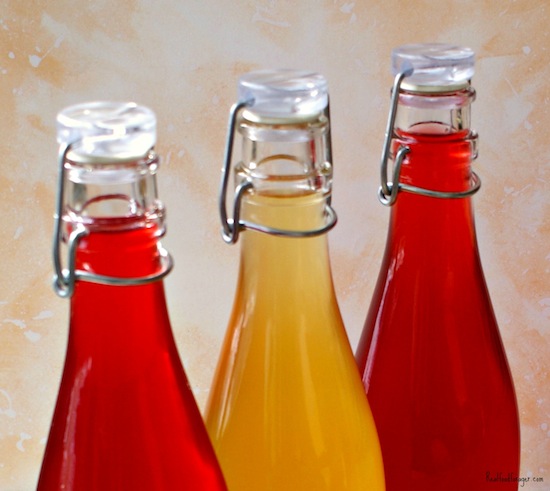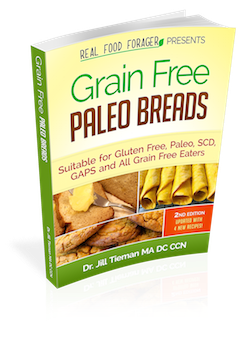Although the Kombucha Challenge is over, I just wanted to add one more recipe. Kombucha is now my favorite beverage. I actually never drink much of anything except water, so this is something new for me. I am really enjoying taking care of my SCOBY and getting this incredibly beneficial beverage from it.
I finally located some cool bottles for the second ferment and I wanted to share the flavors I have been experimenting with. It’s easy to experiment because I am making so much kombucha I am not worried about wasting it if I do not like a flavor. Here’s a few of my favorites.
If this is the first time you are reading about kombucha here, you need to catch up by reading this post to find out what kombucha is and this post to get the basic kombucha recipe.
Kombucha Has a Lot of Important Vitamins
A kombucha culture has a wide range of organic acids, vitamins and enzymes that give it its extraordinary value.
- B vitamins; especially B1, B2, B12 — Important for energy formation and a multitude of metabolic reactions in the body.
- Vitamin C — Important for detoxification and immune support.
Kombucha Has Many Valuable Organic Acids
There are also many important organic acids present in kombucha. Here are some of them.
- Lactic acid is essential for healthy digestion and is produced by the beneficial bacteria in the culture.
- Acetic acid is an antiseptic and inhibitor of pathogenic bacteria.
- Glucuronic acid is a powerful detoxifier. It helps neutralize the toxic effects of plastics, herbicides, pesticides and resins. When toxins enter the liver, they bind to glucuronic acid and get flushed out through the kidneys. Additionally, glucosamines are derived from glucuronic acid and are important to our joints and other collagen and cartilage dependent tissues as well as the fluids which lubricate the joints. These elements are also present in our skin and mucous membranes.
- Malic acid also helps in detoxification of the liver.
- Butyric acid (produced by the yeast) protects mucous membranes and is important in the large intestine.
- Gluconic acid is produced by the bacteria and strengthens the walls of the gut. This helps heal intestinal permeability caused by candida yeasts.
- Nucleic acids, like RNA and DNA, transmit information to the cells on how to perform correctly and regenerate.
- Amino acids produce important enzymes, such as those involved with glutathione, a powerful antioxidant which provides protection from alcohol, pollution and other toxins.
Reading about all these benefits lead me to really want to start to make it. But with anything new, there is a hurdle to get over. I invited you all to join me in the Kombucha Challenge and you all came through! I was able to do this because I knew so many others were doing it as well. For that I can’t thank you all enough! I hope you had as much fun as I did and I hope you met your goals.
Flavored Kombucha
Ingredients
- 1 – 2 quarts of kombucha (see the basic recipe for making kombucha)
- Flavors such as fresh pomegranate, lemon, orange, ginger and unsweetened cranberry juice
Equipment
- Funnel
- 12 – 16 ounce bottles for the second ferment
Instructions
- Ginger Flavor: Slice about a one inch length of fresh ginger into thin slices and drop them into the bottle. Add a squeeze of fresh lemon juice and a squeeze of fresh orange juice. Using the funnel, add the kombucha leaving just an inch at the top. Close the bottle and leave out in a dark cabinet for 3 days.
- Cranberry/Pomegranate: Using the funnel add about two tablespoons of cranberry juice to the bottle. Add the seed of about 1/4 of a fresh pomegranate. Add the kombucha leaving just an inch at the top. Close the bottle and leave out in a dark cabinet for 3 days.
- Cranberry/Orange: Using the funnel add about two tablespoons of cranberry juice to the bottle. Squeeze about two tablespoons of fresh orange juice into a spoon and add that to the bottle. Add the kombucha leaving just an inch at the top. Close the bottle and leave out in a dark cabinet for 3 days.
I loved all of these flavors! The Cranberry/Pomegranate was somewhat tart but that made it interesting. If you do not have the grolsch style bottles, you can do the secondary ferment in ball jars. Just seal them tightly.
Be aware that this second ferment is done to flavor the kombucha and to increase carbonation. You should check your bottles every day to be sure they are not getting to the point where they will explode. I release the air inside the bottle every day to avoid this.











